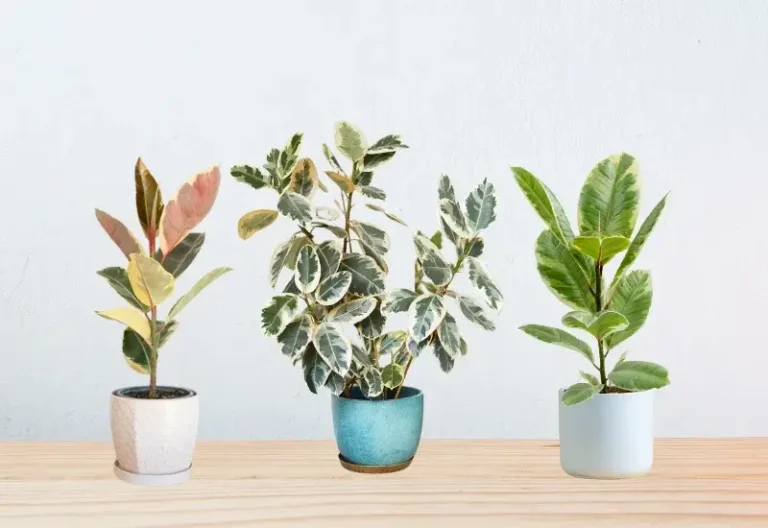Ficus Tineke Care and Growth
Ficus Tineke’s unique foliage and distinctive appearance set it apart from other indoor plants, making it a popular choice among plant enthusiasts. In this article, learn essential Ficus Tineke care tips for thriving plants. Discover optimal light, water, and soil needs, plus growth habits and common issues. Your guide to stunning variegated rubber plants.
| Basic Information for Ficus Tineke | |
| Common Name | Ficus Tineke |
| Scientific Name | Ficus elastica ‘Tineke’ |
| Plant Type | Houseplant |
| Leaf Color | Variegated (Green and Creamy-White) |
| Light Requirements | Bright, Indirect Light |
| Watering Needs | Allow the Top Inch of Soil to Dry Before Watering |
| Soil Type | Well-Draining Potting Mix |
| Common Issues | Brown Edges on Leaves |
| Propagation Methods | Stem Cuttings |
| Air-Purifying | Yes |
| Growth Rate | Moderate |
| Mature Height | Up to 6 feet (1.8 meters) |
The Ficus Tineke, a member of the Ficus family, is a captivating houseplant known for its striking variegated leaves. These leaves feature an exquisite combination of dark green and creamy-white patterns, creating a visually pleasing contrast. The botanical name for this species is Ficus elastica ‘Tineke,’ and it is commonly referred to as the Rubber Plant due to its latex-producing abilities.
Unique Characteristics
The variegated foliage of Ficus Tineke is a masterpiece of nature. The contrasting colors and patterns create an eye-catching display that adds an elegant touch to any room. The glossy sheen of the leaves enhances their appeal and gives the plant a chic, polished look.
The Ficus Tineke is not just a visual delight; it’s also an air-purifying powerhouse. Like other Ficus species, it helps to improve indoor air quality by filtering out common pollutants. This means that as you enjoy the aesthetics of the Ficus Tineke, you’re also benefiting from its air-cleaning capabilities.
Ficus Tineke Care
Caring for Ficus Tineke is a rewarding experience, but it requires a bit of know-how.

Ficus Tineke Light Requirements
Proper lighting is crucial for the health and beauty of your Ficus Tineke.
Specific Lighting Needs: Ficus Tineke thrives in bright, indirect sunlight. This means it needs a good amount of light but not direct sun exposure, which can scorch its leaves. Place it near a window with sheer curtains or in a location with filtered light.
Tips for Providing the Right Amount of Light
To ensure your Ficus Tineke receives the ideal amount of light, observe its response. If you notice the variegated leaves losing their contrast and becoming predominantly green, it might be getting too little light. On the other hand, if the leaves start developing brown spots, they may be getting too much direct sun. Adjust its placement accordingly to maintain the perfect balance.
Ficus Tineke Watering
Appropriate watering is a cornerstone of Ficus Tineke care. The goal is to keep the plant healthy without overwatering or underwatering.
Detailed Guidelines for Watering: Allow the top inch of the soil to dry out before watering your Ficus Tineke. Stick your finger into the soil to gauge its moisture level. When it’s dry to that depth, it’s time to water.
Strategies to Prevent Overwatering or Underwatering: Overwatering can lead to root rot, while underwatering can cause stress to the plant. To prevent these issues, maintain a regular watering schedule and adjust it based on your home’s humidity levels. Always use a pot with drainage holes to allow excess water to escape.
Ficus Tineke Care Tips for Soil
Selecting the right soil for your Ficus Tineke is vital to its overall health and well-being:
The Importance of Ideal Soil: Ficus Tineke thrives in well-draining soil. A mix of standard potting soil with perlite or sand is an excellent choice. This combination ensures that water doesn’t pool around the roots, reducing the risk of root rot.
Tips for Creating an Ideal Soil Environment: When repotting or planting your Ficus Tineke, choose a container with drainage holes and use the recommended soil mix. Repotting can be done every 2-3 years to refresh the soil and provide more space for root growth.
Addressing Common Issues
Every plant has its quirks, and Ficus Tineke is no exception. One common issue is the development of brown edges on its leaves. Let’s explore the causes and solutions:
Ficus Tineke Brown Edges
Exploring the Causes: Brown edges on the leaves can be a sign of low humidity, underwatering, or exposure to drafts. It’s essential to identify the root cause to address the issue effectively.
Practical Solutions:
To prevent or address brown edges, consider the following steps:
- Increase humidity around the plant by misting it regularly or using a humidity tray.
- Ensure your Ficus Tineke is receiving adequate and consistent watering.
- Protect the plant from drafts and sudden temperature changes.
Ficus Tineke Propagation
If you’re captivated by your Ficus Tineke and want to share its beauty with others, propagation is the way to go. Here are some techniques and step-by-step instructions for successful propagation:
Propagation Methods:
Ficus Tineke care can be propagated through stem cuttings. Here’s how:
- Select a healthy stem cutting with at least two leaves and a node (the bump on the stem where leaves and roots grow).
- Allow the cutting to callus for a day or two.
- Plant the cutting in a well-draining potting mix.
- Keep the soil consistently moist but not waterlogged.
- Place the cutting in a warm, bright location with indirect light.
In a few weeks to months, your Ficus Tineke cutting should develop roots and start to grow, giving you a new plant to enjoy or share with fellow plant enthusiasts.
Conclusion
Ficus Tineke is indeed a striking houseplant that can add an element of sophistication to your living space. To nurture its beauty, focus on providing the right amount of light, following a consistent watering routine, and selecting well-draining soil. Address common issues like brown edges with appropriate care, and consider propagating to expand your collection or share the elegance of Ficus Tineke with others.
Also Read: Is Ficus Tineke Toxic To Cats


